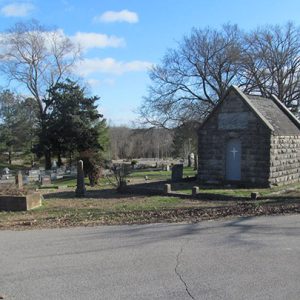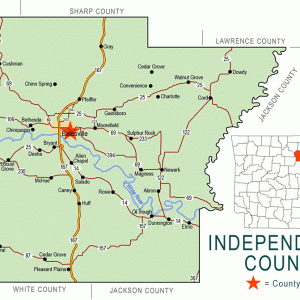calsfoundation@cals.org
Dunnington (Independence County)
The historic community of Dunnington of Independence County was located on Highway 14, about two miles east-southeast of Oil Trough (Independence County). It was about five miles south across the White River bridge from Newark (Independence County) and approximately eight and a half miles from Newport (Jackson County). Being close to the White River, floods were common, at times even devastating. Dunnington was in a two-mile radius of Hulsey Bend (Independence County), Elmo (Independence County), Macks (Jackson County), Meadow Lake (Independence County), and Oil Trough.
As early as 1800, French frontiersmen were in the White River bottoms hunting bears and smaller game animals, including deer. Traffic in bear oil was lucrative and proved to be an incentive for settlement, and the land proved fertile for growing many crops—including corn, which could be used for making liquor. In 1817, pioneer Hardin Hulsey arrived, and others soon followed. Hulsey had a cotton plantation at Hulsey Bend on the White River. Colonel Virgil Young Cook’s plantation at Elmo and the Dunnington plantation, both established after the Civil War, adjoined the earlier one at Hulsey Bend.
The community was named for Ephraim M. Dunnington, a planter from Tennessee who married Rebecca Elizabeth (Eliza) Wright in 1856 in Robertson County, Tennessee. Shortly after the birth of their son, John, in 1858, the family moved to Sulphur Rock (Independence County), where Dunnington’s name appears on the list of those contributing to the building fund for the Sulphur Rock Academy in 1872. Ephraim Dunnington was a cousin to John William Dunnington, a Confederate naval and infantry officer during the Civil War who served for approximately nine months in Arkansas and took part in the Engagement at St. Charles and the Battle of Arkansas Post.
Dunnington had a post office from 1903 to 1918, with Will Calaway appointed the first postmaster. The post office was located in a general store that was later converted into a dwelling. Ephraim and Eliza’s daughter Ella married John Calvin Yancey, who served as the mayor of Batesville (Independence County) from 1889 to 1890 and was appointed postmaster at Dunnington in 1905. Before being mayor, Yancey was a state representative in 1885. Yancey was a prominent attorney of the area and a promoter of the White River Railroad, which was absorbed by the St. Louis, Iron Mountain and Southern Railroad. Yancey drove the first spike in the White River line.
A short time following the opening of the general store/post office, the Dunnington-Yancey cotton gin was built. The two-story building was constructed containing a Masonic lodge on the top floor and a church used by both the Baptists and the Methodists on the main floor. The white school-age children attended the Meadow Lake School, which was still open in 1936. The children of the black farmers attended school at Hindman (Independence County), a few miles south of Dunnington. The Meadow Lake School consolidated with Oil Trough in the 1940s. When Hindman consolidated, black students opted to attend school at Newport’s black school.
Ephraim Dunnington died in 1901, and John Calvin Yancey died in 1907. Both are buried in Oaklawn Cemetery in Batesville. The Dunnington plantation was divided among the heirs. The closing of the post office at the end of World War I was indicative of the decline of the Dunnington community, which remained until sharecropping and the old tenant-farming methods of providing agricultural labor disappeared. The mechanization of farming in the 1960s and 1970s played a role with the replacement of cotton as the dominant cash crop in the bottoms by soybeans, rice, and corn. In the twenty-first century, Dunnington is just a memory for the older generations in the Oil Trough Bottoms.
For additional information:
Biographical and Historical Memoirs of Northeast Arkansas. Chicago: Goodspeed Publishing Company, 1889.
McGinnis, A. C. “Farming in Oil Trough, 1904–1960.” Independence County Chronicle 13 (July 1972): 27–39.
———. “A History of Independence County, Ark.” Special issue. Independence County Chronicle 17 (April 1976).
Kenneth Rorie
Van Buren, Arkansas
 Dunnington Mausoleum
Dunnington Mausoleum  Independence County Map
Independence County Map 




Comments
No comments on this entry yet.